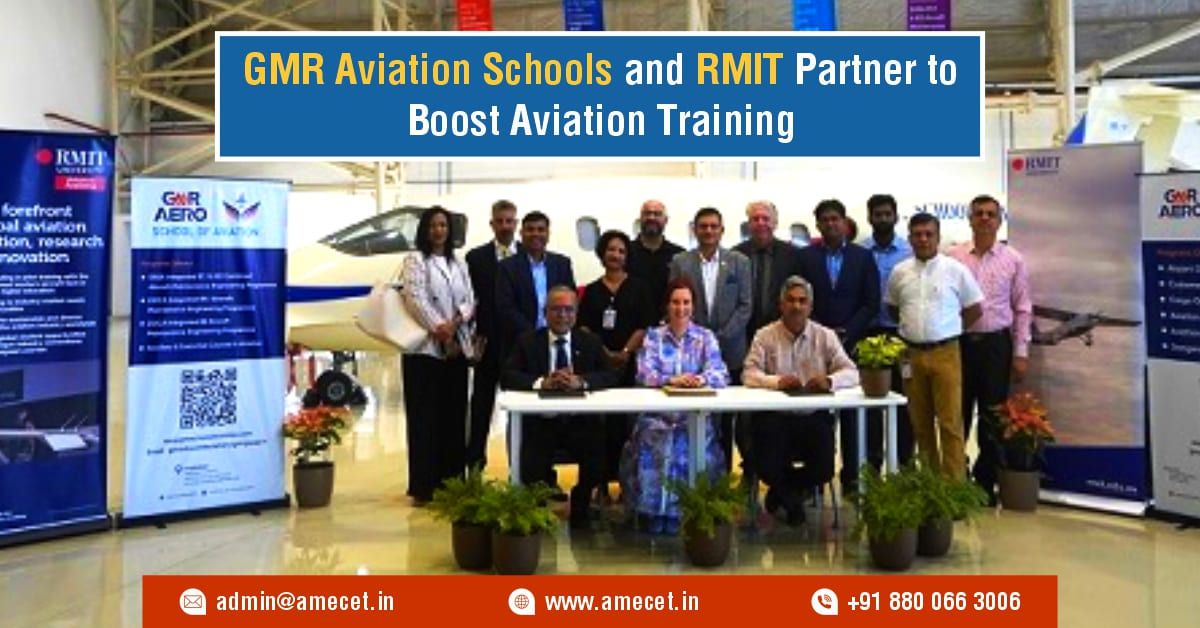
In a significant move to advance aviation training, GMR Aviation Schools has partnered with the renowned Royal Melbourne Institute of Technology (RMIT). This collaboration is poised to enhance the quality and scope of education for students pursuing careers in various sectors of aviation, from aircraft maintenance engineering to commercial pilot training and ground staff roles. By joining forces, GMR Aviation Schools and RMIT are setting a new standard for aviation training that aligns with global industry needs, including aircraft maintenance and engineering, commercial pilot training, and aerospace engineering courses.
Strengthening Aircraft Maintenance and Engineering Education
One of the main highlights of the GMR Aviation Schools and RMIT partnership is the emphasis on aircraft maintenance and engineering. Aircraft maintenance engineers play a pivotal role in ensuring the safety, reliability, and efficiency of commercial aircraft. As airlines and airports continue to grow globally, the demand for highly skilled aircraft maintenance engineers has never been higher.
The partnership will provide students with a comprehensive understanding of the technical and practical aspects of aircraft maintenance. From routine inspections to complex repairs, aircraft engineers are essential for maintaining the high safety standards required in the aviation industry. The new programs will offer courses tailored to meet the needs of commercial aircraft manufacturers and aircraft manufacturers alike, helping to bridge the skills gap and develop a new generation of aircraft maintenance engineers.
GMR Aviation Schools' reputation for providing high-quality training in aircraft maintenance and engineering will be further strengthened by RMIT's world-class resources and expertise in aerospace engineering. RMIT has a long-standing history of offering cutting-edge aerospace engineering courses that equip students with the knowledge and skills to tackle the challenges of the modern aviation industry.
Commercial Pilot Training and Aerospace Engineering Courses
The partnership also opens up new opportunities for commercial pilot training and the development of future aerospace engineers. As the aviation industry continues to expand, there is a growing need for commercial pilots who are well-versed in the latest technology and flight operations. GMR Aviation Schools, in collaboration with RMIT, will offer robust training programs designed to produce highly qualified commercial pilots.
RMIT’s expertise in aerospace engineering will further enhance the training of commercial pilots by incorporating advanced engineering principles into flight training. Understanding the engineering behind the aircraft, including avionics and propulsion systems, is increasingly important for pilots to manage in-flight issues effectively and ensure the smooth operation of flights.
In addition to commercial pilot training, the aerospace engineering courses offered through this partnership will provide students with in-depth knowledge of aircraft design, systems, and technology. This will be crucial for those aspiring to work with commercial aircraft manufacturers or in aerospace research and development.
Ground Staff Training at Airports
Beyond pilot training and aircraft maintenance, this partnership also focuses on enhancing ground staff training. Airport ground staff are the backbone of airport operations, handling everything from baggage handling to security procedures. Proper training for airport ground staff is critical in ensuring the seamless functioning of airports and a positive passenger experience.
GMR Aviation Schools and RMIT will collaborate to deliver industry-leading training programs for airport ground staff, providing essential skills in areas such as customer service, safety, baggage handling, and airport operations. These programs will be designed in close consultation with airlines and airport authorities to ensure they meet the current demands of the aviation industry.
As airlines such as Air India and Air India Express continue to expand their operations, the demand for skilled airport ground staff is growing. The partnership will ensure that airports can provide high-quality services, offering well-trained staff capable of managing the increasing passenger traffic at airports worldwide.
Preparing Future Aerospace Professionals
The collaboration between GMR Aviation Schools and RMIT will contribute to the development of a highly skilled workforce across various sectors of the aviation industry. Aerospace engineering, commercial pilot training, aircraft maintenance, and ground staff training are all integral parts of aviation operations, and the partnership aims to enhance each of these sectors.
For aspiring aerospace engineers, GMR Aviation Schools, in partnership with RMIT, will provide specialized training programs in aerospace technology, equipping students with the knowledge required to work on cutting-edge aviation systems. Students will be prepared for careers with leading aircraft manufacturers, airlines, and airports, with a focus on both the theoretical and practical aspects of aerospace engineering.
The inclusion of aircraft maintenance engineering and pilot training within the partnership ensures that graduates are well-equipped to meet the challenges of the evolving aviation sector. The partnership is designed to be forward-thinking, anticipating the growing needs of the aviation industry, and preparing students to thrive in an increasingly globalized and technologically advanced environment.
Collaboration with Airlines and Airport Operators
The collaboration between GMR Aviation Schools and RMIT also strengthens ties with major airlines and commercial aircraft manufacturers. The aviation industry is highly interconnected, with airlines, aircraft manufacturers, airports, and training institutions working together to ensure the safety and efficiency of operations. By aligning their training programs with industry needs, GMR Aviation Schools and RMIT are helping to create a direct pipeline of skilled professionals ready to join the workforce.
Airlines such as Air India and Air India Express, along with other major global carriers, will benefit from this partnership, as it ensures a steady supply of well-trained pilots, aircraft engineers, and ground staff. With the aviation sector experiencing rapid growth, the demand for skilled personnel will only continue to rise. This collaboration positions GMR Aviation Schools and RMIT as leaders in aviation training, ensuring that students are equipped with the skills and expertise needed to meet the industry’s demands.
Conclusion
The partnership between GMR Aviation Schools and RMIT marks a significant step forward in the development of aviation training. With a focus on aircraft maintenance and engineering, commercial pilot training, aerospace engineering, and ground staff education, this collaboration is designed to meet the evolving needs of the aviation industry. By combining GMR Aviation Schools’ practical training expertise with RMIT’s academic excellence in aerospace engineering, this partnership promises to produce a highly skilled workforce prepared to tackle the challenges of modern aviation.
As the aviation sector continues to expand, initiatives like this one will ensure that there is a steady supply of trained professionals ready to work with airlines, airports, and commercial aircraft manufacturers. The future of aviation looks bright, and this collaboration is helping to shape the next generation of aerospace professionals, making it an exciting time for both students and the industry as a whole.
Category
-
(193)
-
Aeronautical Engineering (2)
-
Aerospace Engineering (3)
-
Aircraft Maintenance Engineer (AME) (1)
-
Aircraft Maintenance Engineering (BTech/BE) (4)
-
Aircraft Maintenance Engineering (DGCA) (55)
-
Aircraft Maintenance Engineering (EASA) (11)
-
Airport Ground Staff (1)
-
Airport Management (5)
-
AME CET (5)
-
B.Sc. in Aviation (1)
-
Cabin Crew (1)
-
Commercial Pilot License(CPL) (81)
